How Facebook’s News Feed works (and what you need to do about it)
With recent announcements about updates to Facebook’s News Feed Algorithm widely hitting mainstream media, a greater interest in this ever-evolving secret ranking system has emerged.
And with Facebook’s daily active user number dwarfing those of any other platform, News Feed Optimization (NFO) has become the new SEO, at least where social media is concerned.
The values governing Facebook’s News Feed have historically been to inform and entertain but in 2018 the emphasis is shifting towards facilitating deeper, more meaningful conversations between friends and people in their networks. Where this is driven by public content – content published by businesses on their Facebook Pages – it is more likely to be from Pages that Facebook has decided are trustworthy – a partial response to Facebook’s role in propagating fake news.
What exactly is the News Feed algorithm?
Facebook’s News Feed algorithm utilises over 100,000 signals in deciding what to show in News Feed. Everyone’s version of the News Feed is unique – completely personal to the individual – and with 2.4bn users that is no mean feat. Facebook makes minor tweaks to this complex algorithm very frequently, and major updates from time-to-time, not dissimilar to the way Google varies its PageRank algorithm that governs search results.
The News Feed is a busy place with masses of content vying for visibility. An unfiltered News Feed would be hopelessly out-of-control and cluttered with irrelevant updates. Facebook says user feedback suggests people object to the overwhelming quantity of content from publishers [although I’d counter that most people are really referring to poorly targeted or uninteresting ads] and this has led to Mark Zuckerberg, Facebook CEO announcing that “public content–posts from businesses, brands, and media–is crowding out the personal moments” and is on a mission to correct that.
We’re all ‘passively consuming’ content and, according to research and Facebook’s (unpublished) studies, it’s bad for our mental health so Facebook is stepping-in to rescue us. Sometimes it all feels a bit Orwellian.
News Feed Optimization (NFO)
For businesses with Facebook Pages getting to grips with News Feed Optimization – the art of getting maximum visibility for your Page’s Facebook content but without paying for promotion – is increasingly part of the social media marketer’s skillset.
Facebook doesn’t publish the details of the algorithm beyond occasional broad guidelines and during the odd interview or conference talk. In recent years it has clamped down on shady practices like click bait, prioritised content from friends and family, and most recently decided to focus on content that “drives conversation”, often at the cost to public content posted by business Facebook Pages.
It can come as a big shock to businesses running Facebook Pages when they discover only a tiny fraction of their fans and followers are shown the updates they invest so much time and money crafting. This ‘organic reach’ as it is known is the holy grail for Facebook marketers; essentially free marketing. It’s the Facebook equivalent to being on the first page of Google or Bing without paying to advertise.
However, Facebook has been steadily reducing the organic reach of Facebook Page public content over the years as it steers businesses towards a pay-to-play model, paying to ‘Boost’ public content to the audiences these businesses have accumulated on their Facebook Pages.
The algorithm is the villain responsible for the plummeting organic reach of posts on Facebook Pages. The most recent data indicates that on average only 7% of a Page’s followers will see its content (Locowise study from December 2017). Other studies put it as low as 2%. But these figures are likely overstating the position due to the questionable method Facebook used to calculate post reach. That’s now changing meaning reach figures are likely to go into freefall as the double-whammy of recent algorithm updates and reporting fixes take shape. Watch out if you run a Facebook Page; if you thought the organic reach of your posts was bad now, just you wait.
I’ve recreated the key elements of the algorithm in a framework that most of us are familiar with from school science classes. The Periodic Table of Facebook News Feed Optimization covers all the key drivers that deliver organic reach for Pages and this article goes into each of those element in detail.
I’ve spent several years carrying out academic research and studies into the key factors that govern the Facebook News Feed algorithm. Given it is such a moving target it is no surprise that many of the models, frameworks and advice found online are hopelessly outdated.
I’ve therefore proposed a new summarised model of the algorithm which has been updated to incorporate the latest updates.
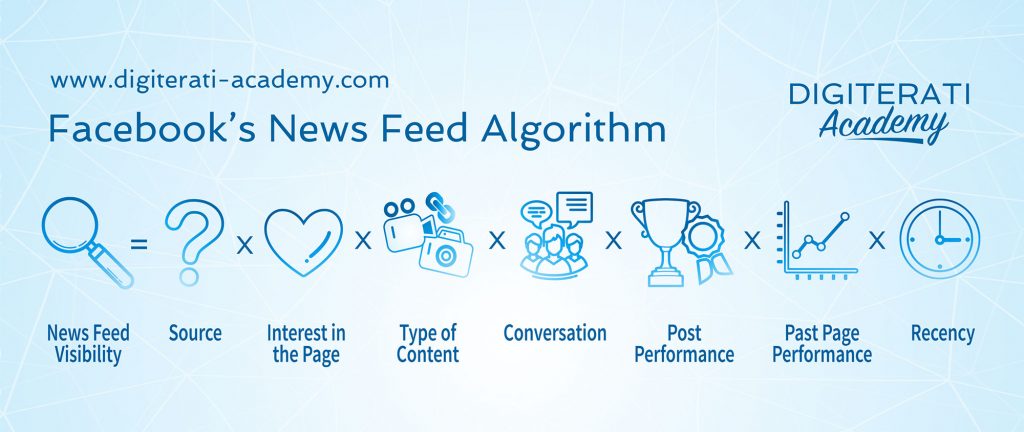
Eight elements encompass some 100,000+ factors. Understanding these overriding elements that drive News Feed Optimization businesses with Facebook Pages maximise the number of people who see their content.
Let’s look at each of those elements in turn.
The different elements of the News Feed Algorithm
The main goal for businesses running Facebook Pages is News Feed visibility (aka organic reach). Some factors are strong drivers in contributing to reach, others play a very minor role.
In February 2018 Facebook gave some indicators on the current signals that News Feed now uses:

The emphasis here is strongly on peer-to-peer communications, the elements in blue being considered the most important.
The Source
Content from Pages competes with updates from friends and family as well as ‘sponsored’ content.
In January 2018 Facebook’s Adam Mosseri, Head of News Feed, said “Facebook was built to bring people closer together and build relationships. One of the ways we do this is by connecting people to meaningful posts from their friends and family in News Feed. Over the next few months, we’ll be making updates to ranking so people have more opportunities to interact with the people they care about.”
We know from that statement (and our personal experiences of being Facebook users) that we do indeed see content from friends and family. And we’re more likely to see content that has lots of comments. It is this highly engaged content that you’ll be seeing more of in the future, likely at the expense of content from Facebook Pages unless it too is highly engaged with.
The algorithm learns which friends people interact with a lot and will show more (maybe all) of their content. It will also prioritise showing interactions from friends that are held in common.
The ‘source’ (where or whom a post comes from) of a post majorly impacts the visibility of a post.
- Who posted it?
Content from close friends and family is prioritised - Did a Facebook Page post it?
This ‘public content’ is bottom priority in the algorithm’s preferences and the visibility of the post will also very influenced by other factors - Is the Facebook Page or news local to you?
Currently in testing in the US and being rolled out over 2018 will be a prioritisation of local news - Did a Facebook Group post it?
Facebook is determined to build community and sees Facebook Groups as central to this aim. As a result, posts from Groups currently get way more reach than Pages. I’m finding reach in my Facebook Group to be about 65% at the moment - Is it an ad?
Ads are often prioritised over public content by Pages people explicitly ‘opted in’ to hearing from; those they ‘Liked’. My own recent research amongst Facebook users is finding one ad for every five or so organic posts: make no mistake about it – Facebook is a revenue driving machine. Whilst there is still a (very different) algorithm controlling which ads are seen, we are unlikely to see an ad-free News Feed ever again. And sadly, it is poorly targeted ads that are the cause of so much discontent with Facebook amongst users.
Interest in the Page
If someone is going to see organic public content from a Facebook Page they will need to have sent some VERY strong signals to Facebook about their interest in the Page. Currently these include the option to adjust settings on a Page to ‘See First’ or ‘Get Notifications’. People can also educate the algorithm a little by frequently engaging with content from their favourite Pages.
Other drivers in this ‘Interest in the Page’ category include factors such as:
- How recently they became a fan of the Page (prioritising content to new followers)
- Users also occasionally see content because a friend liked or commented on it. This is called viral reach.
Type of Content
The algorithm has different weightings for different types of post. And some content types (such as videos and photos) are naturally better at driving engagement. Engagement, particularly if it is considered ‘meaningful’ is a big influence itself on reach. The type of content that is seen depends on a combination of user and algorithmic preference. Users who watch a lot of video will be shown more video than other content types. But Facebook also has its own priorities.
It prefers to keep people within the virtual walls of Facebook so links to external websites are not prioritised. Link posts make up a considerable percentage of business Page posts as well as those of media publications using social media to drive traffic to their websites.
Facebook even considers the quality and load speed of the landing page that links go to. 40% of users will abandon a site after a delay of just 3-seconds.
For Pages wanting to get creative with content type Events, Notes and Offers all bring some novelty to News Feed for users as well as enjoying some favour with the algorithm.
Conversation
Facebook has confirmed that “Pages whose posts prompt conversations between friends will see less of an effect” in the reduction of reach. This comment is telling – note the “conversations between friends” element. I can see some Page categories benefitting hugely from this – Passion Pages such as bands and music festivals where people typically use the comment thread to tag and chat with their friends about attending and meeting up lend themselves to this type of conversation which Facebook will recognise as a meaningful social interaction.
Zuckerberg has said “We want the time people spend on Facebook to encourage meaningful social interactions”.
In a live webinar for the Facebook Journalism Project in February 2018 some examples of meaningful interactions that will be prioritized were given:
- A person commenting on or liking another person’s photo or status update
- A person reacting to a post from a publisher that a friend has shared
- Multiple people replying to each other’s comments on a video they watched or an article they read in News Feed
- A person sharing a link over messenger to start a conversation with a group of friends
This post by Barn on the Farm Festival had stratospheric engagement in comparison to their usual posts due to the responses to questions and the discussions between friends:
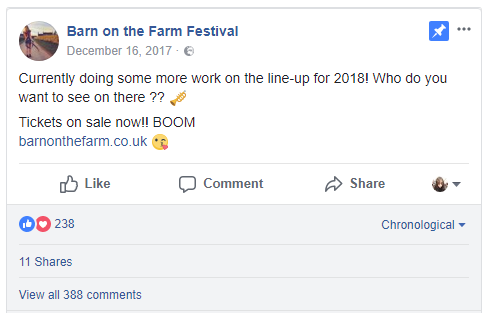
What can Pages do to encourage conversation whether between friends or simply within the thread? Copy should be written in an open, conversational, questioning style.
What about controversy?
As well as content that connects with a Page follower’s sweet spot, controversial content can also provoke that all important “meaningful conversation”. Strong opinions get shared and keyboard warriors go to town pushing up the engagement indicators to the algorithm. However, Pages that regularly embrace such approaches tend to attract a certain type of follower and for many users the response is to unfollow or hide the content. And this activity sends a negative ranking signal to the algorithm which can in turn damage the Page.
Post Performance
Beyond the notional type of content, the subject matter and how it is presented are the largest drivers of performance. In the new regime the key is content that engages followers and drives meaningful interactions. This update from BBC Radio 4’s The Archers is a good example of a post that drives conversation:
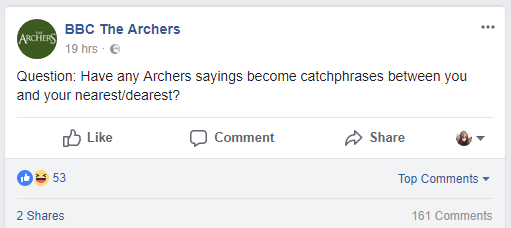
The responses are comedy-gold for Archers fans who revelled in a chance to indulge in a guilty pleasure and the resulting conversation within the thread will have significantly enabled reach.
Facebook’s preference is strongly on content that drives conversation in the comment threads. The holy grail is lots of to-and-fro replies. Facebook has declared war on passive consumption of content and will instead reward posts that facilitate conversation.
Administrators behind The Archers’ Facebook Page encouraged comments in the early part of the thread with witty replies. Humour is often integral to content that gets good reach and engagement.

Facebook Pages must now aim to craft posts that provoke conversation and meaningful interactions. But let’s just drill down a little more to the elements that result in a top performing post:
- How well is this post performing with other users?
If it is driving clicks, reactions, likes, comments and shares that post will be rewarded with additional reach. Reactions (Facebook’s emoji faces) are weighed more heavily than simple Likes, with comments most strongly favored. - What are the comments like?
Facebook recently told Wired Magazine that “we’re going to be (weighing) long comments more than short comments”. And with the focus on ‘conversation’ comments that lead to replies will drive reach. - Is the Page trying to ‘game’ the algorithm by asking for likes and shares?
Facebook clamped down on Pages using engagement bait and asking for Likes, Comments, Shares, Tags and Reactions
It has also stamped out Pages using Reactions as a voting mechanism. One Facebook Page I recently investigated had seen its reach drop from a huge 150% to under 2% as a result of losing the advantage it had gained from looping videos asking fans to vote on a topic using reactions. They will need to radically rethink their posting strategy to thrive again.
Relevancy is only part of the picture. And likes are not enough either
Facebook’s previous emphasis on relevant content has evolved according to Zuckerberg who recently stated “I’m changing the goal I give our product teams from focusing on helping you [users of Facebook] find relevant content to helping you have more meaningful social interactions.”
I’d suggest that relevancy still has its place as does the priority for informative content (albeit content informed by user click and engagement history). There’s going to be minimal interaction on irrelevant content but do see the shift.
The emphasis on meaningful social interactions is way more than simply liking or sharing a post which is way too cheap and easy.
What’s in the content?
Content that Pages should avoid posting
The algorithm has an aversion to content that baits engagement and Facebook has renewed its commitment to clamp-down on posts that actively goad people into commenting, liking, sharing or similar.
Pages utilising click bait techniques with over-sensationalised headlines have seen reach plummet thanks to algorithmic policing.
Other content that is actively throttled is anything from a Page that is salesy or product focussed. This type of content should be in an ad.
Water filter company Brita employs a distinctly non-salesy approach on its Facebook Page. Without a shred of obvious promotion their posts are a combination of environmental campaigning, wellbeing and healthy living; topics that many of their followers embrace.
Brita’s content is in keeping with a company vision to change the way people drink water sustainably. The work on the Facebook Page aligns the brand with issues and causes adjacent to their core product but without product links or references. This post picks up on the current concerns about plastic pollution:
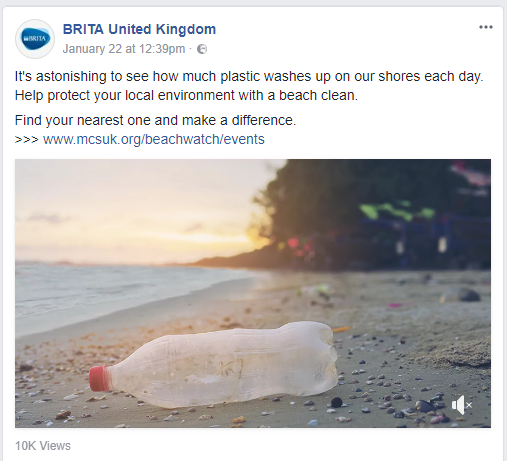
And this post follows the theme with curated content:

Other techniques that Pages have traditionally employed to boost their reach are increasingly ineffective. Tagging a person or Page is not viewed as a meaningful interaction so is “not taken into consideration for post ranking”.
There is no evidence that hashtags – beloved of Instagrammers – help Pages with reach at all. Facebook’s verdict on hashtags was scathing:
“Pages should not expect to get increased distribution simply by sticking irrelevant hashtags in their posts. The best thing for Pages (that want increased distribution) to do is focus on posting relevant, high quality-content – hashtags or not. Quality, not hashtags, is what our News Feed algorithms look for so that Pages can increase their reach.”
Past Page Performance
The recent updates confirm Facebook takes a view of a Page’s past performance when allocating reach. This means that tumbleweed posts will affect future reach efforts. This is a vote for quality over quantity.
In response to the criticism Facebook has received for its role in perpetuating fake news, the platform has now enabled users to report fake news, hate speech, spam and more. Pages that receive a lot of negative feedback of this sort (even just hidden content) will see the trust Facebook has in them eroded.
Techniques Facebook uses to inform the algorithm of the trustworthiness of a Page include grey and blue tick verification and research via user polls and panels.
Facebook has confirmed that completeness of Page profile information is also a News Feed ranking signal.
Facebook has pushed the use of Messenger as a customer service tool in recent months and has invested heavily in improving its functionality. As such we could well assume that the response rate (and even the content of the messages themselves) influence its view of the Page.
The size of Page will also have an impact the reach of individual posts with small Pages tending to enjoy better reach than larger Pages.
Recency
Recently posted content is more likely to be seen. Pages should research when their followers are online and post in those windows.
This data is readily available to Page Admins, however optimum times are often in the evening and at weekends when employees, agencies and Page Admins are not available to monitor and respond to comments. As such this time can be a big opportunity for savvy Pages when the News Feed has less commercial content vying for attention.
Page administrators often schedule posts into the future using third party software or Facebook’s own scheduling tools. Whilst this can surface new content to News Feed in out-of-office hours
I would suggest that if something is truly newsworthy it is generally posted immediately rather than scheduled – and Facebook knows that – it’s called ‘News’ Feed for a reason.
Occasionally users see an older story in News Feed. This is the impact of an algorithmic element called ‘Story Bumping’ which resurfaces content that is getting a lot of sudden engagement.
How Should Businesses Respond?
Facebook’s own advice for Page admins following recent News Feed changes is to:
- Promote meaningful interactions
Stories and videos can help start conversations between people and among your page followers - Focus on your audience
Keep posting content that resonates with your audience and focus on community building - Avoid ‘engagement bait’
‘Engagement-baiting is not a meaningful interaction [and] can result in demotion of page posts
In light of all these updates, how should those operating Facebook Pages respond? Pages used to spamming the News Feed with multiple posts a day are going to need to make radical changes. Those that focus their Pages on quality over quantity will see better returns but to turn out genius, viral-potential posts on a day-to-day basis is nigh on impossible.
Producing quality content that engages people is hard. It takes time, inspiration and a deep understanding of the target audience and what makes them tick.
Facebook, like Google, is increasingly a pay-to-play platform with some 40% of business content now paid promotion. But as with Google, where the art of Search Engine Optimization has been long considered a prized skill highly-valued by businesses, people are beginning to learn the specific approaches and techniques needed to master the News Feed in a similar way. Connecting the right content with the right audiences to drive positive business outcomes. News Feed Optimization, if you will.
Going forward the majority of businesses without the requisite skills will need to allocate ad budget to pay to get their message out there. The days of free and easy on Facebook are long gone.
One thing that is certain; in a matter of months some of the findings and methods I outline above will be outdated, to be superseded by whatever Facebook deems most appropriate in keeping people coming back to Facebook and spending quality time on the platform. Being a specialist in News Feed Mastery I’ll be following this closely with ongoing updates. Stay tuned!
Watch the video Masterclass about the News Feed Algorithm
Head over to the Digiterati Academy for Marie’s brand new, in-depth Masterclass on the News Feed algorithm.
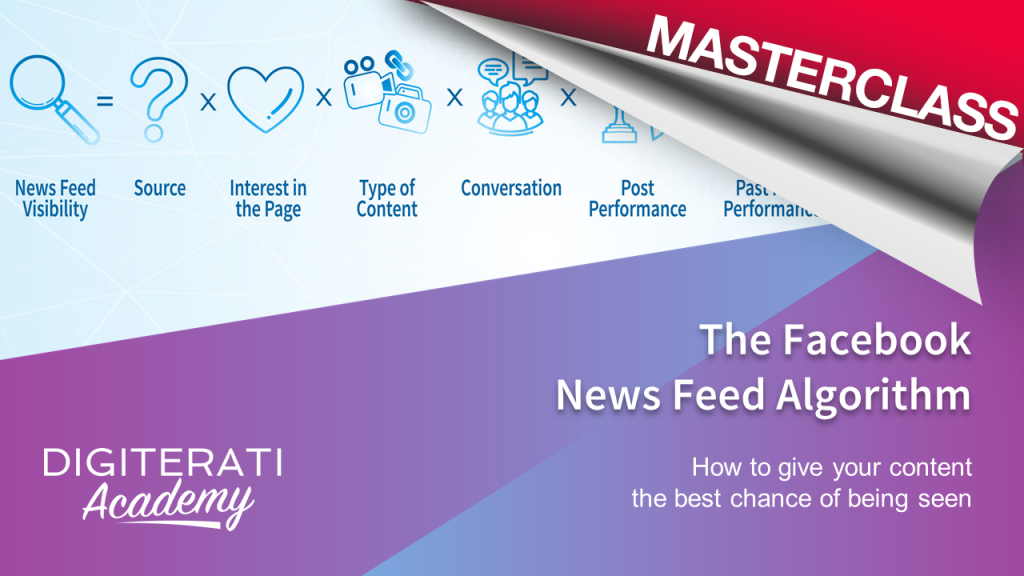
For even more detailed advice on how to maximise your chances of organic reach check out our flagship course Facebook News Feed Mastery.
- How to set up appointments on your Facebook Page - 19th March 2019
- Social media content idea: WordSmith Cards - 11th March 2019
- Facebook for small businesses in 2019: a Q&A - 7th March 2019
- Is it best to boost a post on Facebook, promote a post or create an ad? - 13th October 2018
- What is the difference between a boosted post, a promoted post and a Facebook ad? - 13th October 2018
- How not to £@%!-up on social media! - 24th September 2018


